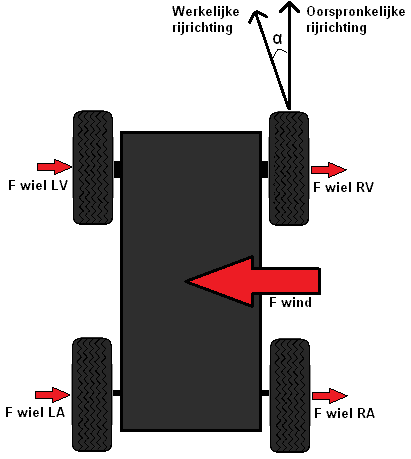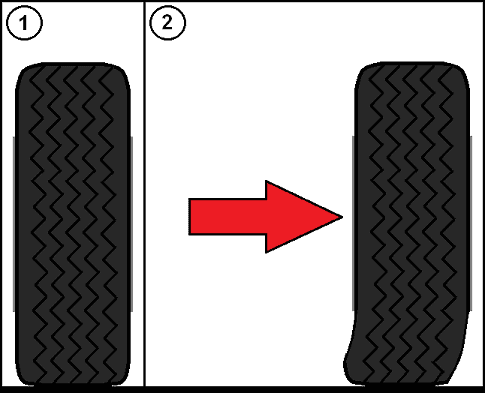Subject:
- drift angle
Drift Angle:
De cheek of the tire is always flexible. The advantage of this is that the part deforms when there are obstacles on the road surface. The disadvantage is that when steering, the sidewall provides poorer stability. The tread wants to follow the steered driving direction, but the wheel itself will move in a different direction based on the lateral force. The drift angle is the angle between the original and the actual direction of travel. This can be clearly seen in the image below.
The original direction of travel is straight ahead. There is no sending. The big red arrow with “F wind” indicates the crosswind; it pushes against the car. The sidewalls of the tires are deformed by the lateral force.
The deformation changes the direction of travel of the car. With the crosswind it follows the arrow of the actual direction of travel. This means that the driver has to countersteer in order to still maintain the original direction of travel. A larger F wind creates a larger angle between Actual and Original direction of travel. The angle between them is therefore called the drift angle.

Here are two situations:
- The wheel in the normal (rolling) situation.
- There is a shear force on the wheel. The transverse force presses against the hub and the center of the rim, as now in the direction of the arrow. The tread remains “sticky” to the road surface. The sidewall of the tire provides flexibility between the tread and the rest of the tire. The height of the sidewall and the tire pressure have a major influence on the deformation of the sidewall.
It is of course now understandable that a soft cheek does not benefit the driving characteristics of the car. The higher the sidewall is (and the softer the tire pressure), the more it deforms. The tire size 195/65R15 has a high sidewall and the size 225/40R18 a fairly flat sidewall. The tires have the same rolling circumference, so they are similar. The 15″ tire will lean more in corners than the 18″. That makes the 18″ a suitable tire for sportier driving. There is also more feeling between the steering wheel and the road surface. The disadvantage of the flatter stiffer sidewall is that the comfort deteriorates, because the car then becomes stiffer. The sidewall is in fact too flat to have just as good a spring effect as the 15″.

